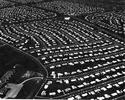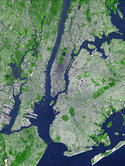Much of the media has been fascinated by the growing number of megacities (built up urban areas with at least 10 million residents). Not only are megacities regularly covered but various reports have them becoming denser. They’re not, as has been demonstrated by Professor Shlomo Angel, who leads the Urban Expansion Program at New York University’s Marron Institute. read more »
City Sector Model
Expanding, Productive Mexico City: The Evolving Urban Form
- Login to post comments
Suburbs & Exurbs Continue to Dominate Metropolitan Growth at Mid-Decade
America’s suburbs and exurbs continue to receive the most population growth among the 53 major metropolitan areas. This is indicated by data in the just released 2013-2017 American Community Survey (ACS), which provides a mid-decade snapshot of US demography. With its middle sample year of 2015, the 2013-2017 ACS is most representative of the middle of the decade between the 2010 and 2020 censuses (Note 1). read more »
- Login to post comments
Suburb & Exurbs Dominate House Building Over Six Decades
In recent years we have been using the City Sector Model (Figure 6, see City Sector Model Note below) to analyze the extent of urban core, suburban and exurban trends in major metropolitan areas. The City Sector Model gives a more accurate picture of how much modern metropolitan areas are dominated by the automobile oriented suburbanization that has occurred since World War II. read more »
- Login to post comments
Larger Metropolitan Areas Dominated by Suburban & Exurban Population
Since 2014, the City Sector Model has been used to portray population trends by functional area within the 53 major metropolitan areas (major metropolitan areas). The current edition classifies small areas (zip code tabulation areas) by demographic factors into five categories (Figure 1). The first two are urban core (central business district and inner ring), while the last three are suburban or exurban. read more »
- Login to post comments
Suburbs & Exurbs Grab Nearly All Metropolitan Growth
The pattern of suburban (and exurban) population growth in the suburbs and exurbs that has dominated the United States since World War II has returned and is intensifying. This is evident from the latest American Community Survey (ACS) data for the 53 major metropolitan areas (more than 1 million population) as analyzed by the City Sector Model (See Note: The City Sector Model). read more »
- Login to post comments
America's Most Suburbanized Cities
Recently, The Wall Street Journal and Newsday, in a photographic spread, trumpeted the 70th anniversary of Levittown, the New York suburban development that provided the model for much of the rapid suburbanization that occurred after the Second World War in the United States. Levittown's production line building also set the stage for the similar suburbs of cities in Canada, Australia, New Zealand and elsewhere. read more »
- Login to post comments
2010-2013 Small Area Data Shows Strong Suburban & Exurban Growth
The latest small area estimates from the Census Bureau indicate that suburban and exurban areas continue to receive the overwhelming share of growth in metropolitan areas around the country, with a single exception, New York. The new American Community Survey (Note 1) 5 year file provides an update of data at the ZCTA (zip code tabulation area), which are described below, as analyzed by the City Sector Model. The data was collected from 2011 through 2015, and can therefore be considered generally reflective of the middle year of the period, 2013. read more »
- Login to post comments
Suburban Nations: Canada, Australia and the United States
Professors David L. A. Gordon of Queens University (Canada) and Paul Maginn and Sharon Biermann of the University of Western Australia have now shown Australia to be a largely suburban nation. This follows on Professor Gordon’s work with colleagues in 2013 that came to the same conclusion on Canada based upon 2006 census data. read more »
- Login to post comments
World’s Most Affluent Areas: Dominated by Low Population Densities
The Brookings Institution is again out with data on the world’s most affluent metropolitan areas. The GDP data is in Redefining Global Cities, which contains a treasure trove of data. read more »
- Login to post comments
Urban Containment, Endangered Working Families and Beleaguered Minorities
Working families and the middle class are becoming an increasingly endangered species in many parts of United States. Median household income remains below its 1999 peak (inflation adjusted). But the problem is not just stagnant incomes. Expenses are also rising, especially the costs of housing in some cities. As a result, it is becoming more and more difficult to make ends meet. read more »




















